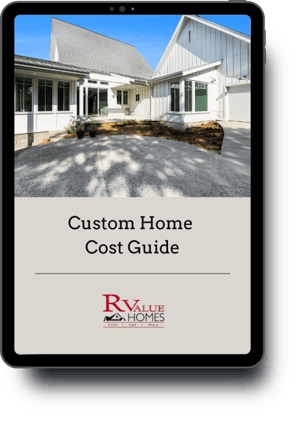4 Min Read
Ventilation and Your Custom Home: All You Need to Know
RenewAire, Fantech and Zehnder, oh my! You’ve decided that balanced ventilation is important in your new construction. Now a whole world of options lies before you. Choosing the proper ventilation for your project can be overwhelming. We all want to avoid common mistakes and use the best equipment possible for our project. How do you know which E/HRV to use?

At R-Value Homes, we have spent years matching ventilation systems to our insulated concrete form (ICF) homes. This marriage of airtight homes and expertly designed ventilation creates comfortable, healthy homes that stand the test of time. Check out our pricing guide if you’re interested in a custom home in Grand Rapids, Michigan.
Do I need an ERV or an HRV?
Many homes, especially older ones, do not address ventilation at all. Fresh air enters and stale air leaves through leaks and cracks. If a house is intelligently ventilated, especially if the home is air-tight, it needs a way to bring fresh air in and exhaust stale air. There are several options for ventilation in your new construction, but we strongly recommend ventilation that addresses both air intake and exhaust; a strategy known as “balanced ventilation”. In our climate, the best options for new home ventilation are either an ERV or HRV. Deciding between the two requires us to dive into one key difference.
An Enthalpy Recovery Ventilator (ERV) is often improperly known as an Energy Recovery Ventilator. Energy can be a much easier word to remember, but it doesn’t paint the whole picture. An ERV features a core that exchanges both heat and humidity. The capacity to transfer humidity differentiates an ERV from an HRV (Heat Recovery Ventilator). One advantage of using an ERV is that it doesn’t bring in outdoor humidity in the summer months, or lose indoor humidity in the winter. But this is not right for every home.
Many variables affect the amount of moisture created and removed from your home. For example, more occupants create more moisture. Kids leave doors open. Long, hot showers add more humidity than shorter, cooler ones. These are a few human factors contributing to a home’s humidity level. And your specific outdoor environment adds countless more!
The different ventilation needs of an airtight home are more evident in the winter. Our concrete homes do not quickly dry out in the winter. Many people think their furnace or woodstove dries the air. Nope. Typical homes dry out in the winter because they are leaky. Warm, moist air leaks out and dry outdoor air replaces it. But an airtight home does not have large leaks, so humidity builds up as occupants put moisture into the air in their homes by showering, cooking, and breathing. You’ll know if your home is too tight for no ventilation when it doesn’t dry out in the winter or feels stuffy. You can be sure by using an air quality monitor, like those by Airthings or Awair.
In some homes and for some families, there is simply too much moisture produced during daily living. An HRV is necessary to remove moisture during the winter to keep humidity levels low enough to prevent condensation on windows and in walls, causing mold, rot, or other unpleasant consequences of excessive moisture in the home. But for other families and homes with a lower natural humidity output, an HRV would dry the house out too much for comfort and health, so an ERV, is the right choice.
How do you know which system is right for your new build? Using variables such as those outlined above, a good HVAC engineer can help you evaluate your ventilation, or an experienced builder can give you an educated opinion. Your process will depend on your construction firm.
Electric Use Versus Efficiency
Your energy modeler and/or builder will use this information to select the best ventilation strategy for your situation. Once a strategy is determined, choosing the right manufacturer and model comes next. Less expensive models use more electricity to operate and transfer less energy, whereas highly efficient models transfer much more energy between the fresh and stale air streams and use ECM motors for further energy savings. However, cost and climate are also important factors. A $6,000.00 model may not be cost-effective for a small home in Climate Zone 4, and a $700.00 model may not be the best choice for a net-zero home in Climate Zone 6.
E/HRV Size and Features
The E/HRV you select depends on the size of your particular home. There is a minimum CFM (cubic feet per minute) flow requirement in certain rooms. Your needs will vary based on family size, # of bathrooms, how you intend to cook, etc.
Various models carry features that may be appealing. Some E/HRV models are controllable with a humidistat. Some measure actual CO2 levels in each room and move air accordingly. Some are only on/off, while others are variable speed.
Our Process to Match Homes with Ventilation Systems
Finding the right ventilation system for the project is just one step in our journey to build your custom home. When selecting your E/HRV, our process looks like this:
- We take the time to understand your family and how you plan to use the home.
- We consider your floor plan and the specific requirements and challenges of your home.
- Then we research energy ratings and ventilation capacity of available models, considering your budget, and select a particular E/HRV.
- Finally, we send the all HVAC (heating, ventilating, air conditioning) equipment specifications with your home’s drawings, location, and insulation details to an energy modeler who projects the total heating and cooling load, as well as annual usage. We use these results to identify areas of improvement.
An alternate method is to hire an HVAC engineer to specify all heating, cooling, and ventilation equipment, and run the energy models. This is the best way to ensure you have the right equipment for the job.
Talk to West Michigan’s Expert
Every single home we build features balanced ventilation with energy recovery. Installing the right one may not give you the same in-the-moment jolt of excitement as that backsplash tile you picked out, but its impact on your family’s health, comfort, and finances are ar more significant. It is worth the effort to get it right! We love building dream homes in the Grand Rapids area, and we’re looking forward to answering your questions. We can’t wait for you to experience the quality custom home that results from our passion for building tight and ventilating right. Reach out to our amazing team today to get started!




.png?width=352&name=What%20is%20an%20Airtight%20Custom%20Home%20and%20Do%20You%20Need%20One%20in%20Grand%20Rapids_%20(1).png)
.png?width=352&name=Blog%20Headers%20(4).png)